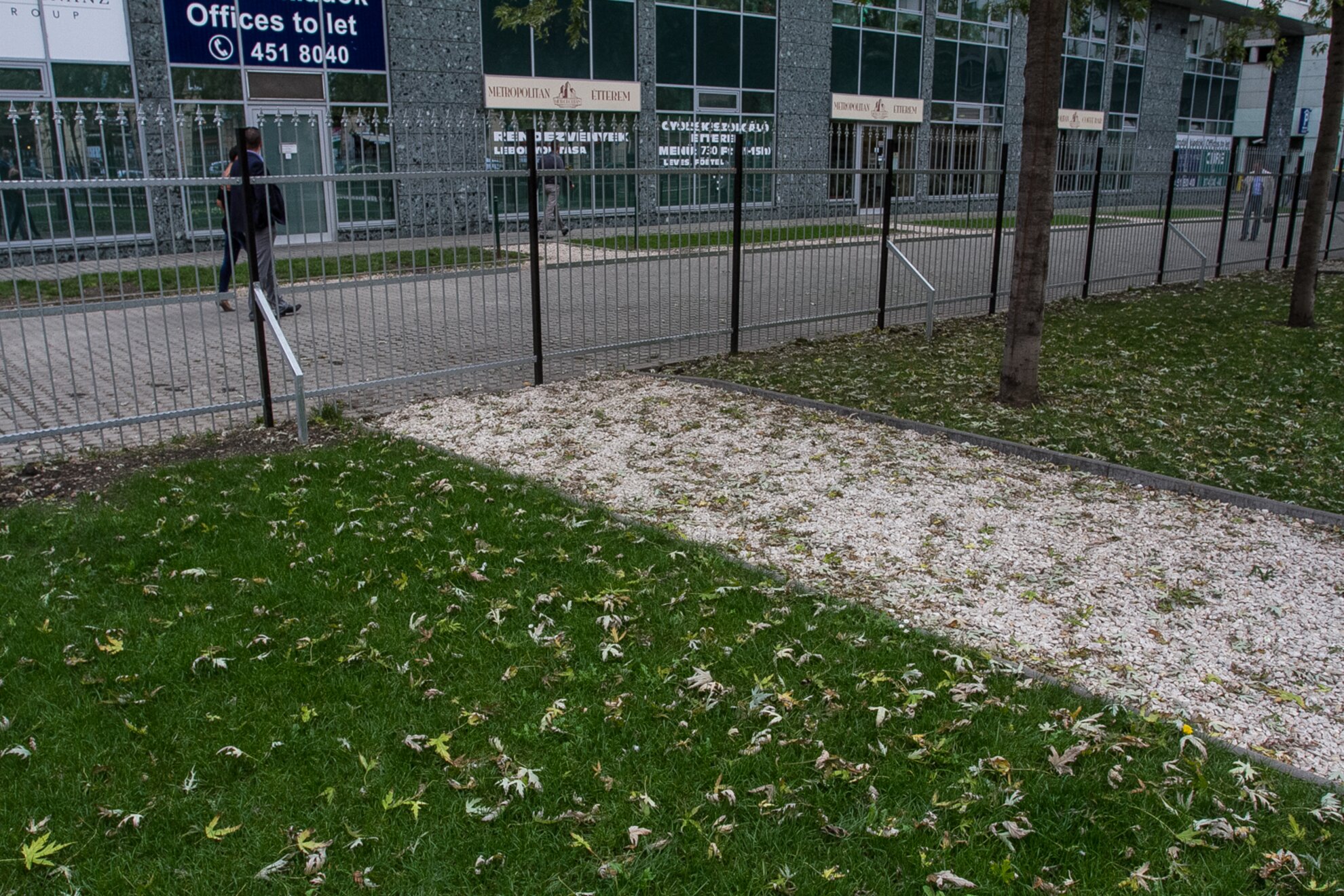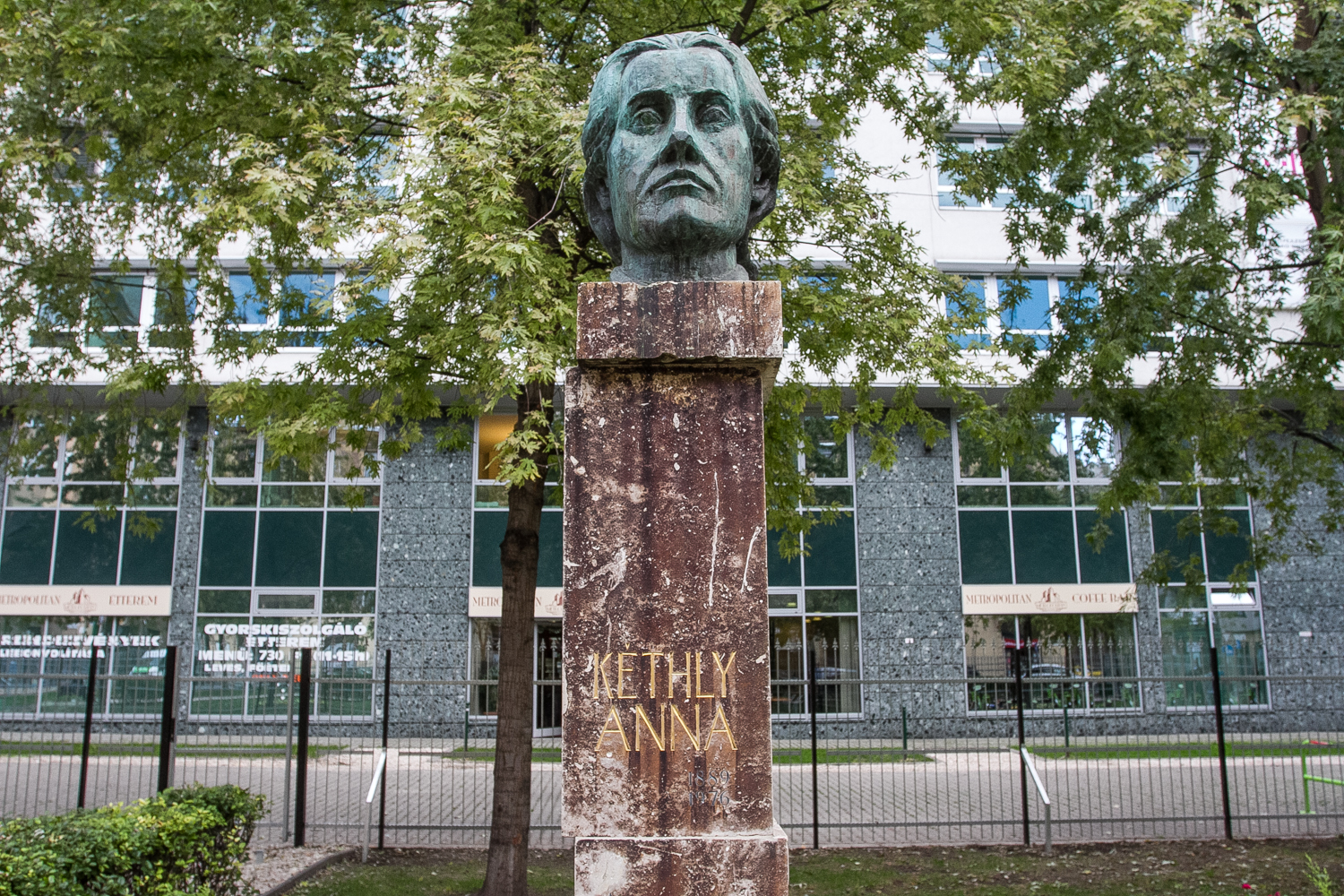Always gated to prevent vandalism, Anna Kéthly Square was refurbished a few weeks ago with new spike-tipped bars surrounding the entire perimeter, which certainly does not encourage people to come in and relax on the benches lining the gravel pathways. Entering the park from Wesselényi, the path to the left leads to a right turn and then mysteriously concludes at a section of fence with no exit gate. Some sort of video-screen display topped with a blue siren – appearing to be an emergency-call device – remains non-functional, as it has been for years.

The main benefits of the renovation appear to be the thorough cleaning of the dog run (certainly appreciated by terrace diners at the oft-downwind Klauzál Café directly across the street), some new lampposts, rejuvenation of the grassy lawns, and the fact that there were no changes to the statue honoring Anna Kéthly – a minimal but reverent tribute to an extraordinary Hungarian woman who continually stood up against both her own government and the planet’s most threatening powers on behalf of social justice for the Magyar people. Like so many politicians who refuse to compromise their principles, Anna Kéthly paid a severe price on multiple occasions for her noble efforts, and on the eve of Hungary’s October 23 holiday commemorating the 1956 Revolution against Soviet oppression – in which she served as the top international diplomat for the freedom fighters – we should remember her many selfless contributions to this country’s history.

Born in Budapest in 1889 to a working-class family of nine children, Anna Kéthly began working at a garment factory at 15 years old, but a year later she found new employment in the editorial office of a women’s magazine, providing the opportunity to continue her education and leading to a respected career as a writer and editor. In 1917, she joined the Hungarian Social Democratic Party and was elected to its Central Women’s Steering Committee two years later, leading to her election to Parliament in 1922 as the second female MP in Hungary’s history.

Along with her ongoing journalism work, Anna Kéthly continually served as a Member of Parliament for the next two-and-a-half decades, pursuing an agenda of worker’s rights and social equality. Despite her center-left ideology, she managed to retain her post within Hungary’s increasingly right-wing government throughout the onset of WWII; she fled to the countryside and began living under an assumed name only after the Nazi regime officially took over the nation.
Anna Kéthly returned to Budapest and her Parliament seat after the Nazis’ defeat, only to find her new opposition coming from the left. Against overwhelming pressure by Stalinist forces in Hungary’s post-war leadership, Anna Kéthly spoke out against the forced merger between her Social Democratic Party and the Communist Party, but in 1948 she was dismissed from her post and deprived of her party membership, resulting in her removal from Parliament and a period of house arrest lasting two years. In 1950 she was detained and given a show trial before being convicted of spying and engaging in activities against the state, and sentenced to life in prison. Under international outcry, she was released four years later, but remained marginalized in Hungary’s Soviet-controlled society.

Nonetheless, widespread antipathy against the Kremlin-backed regime grew among the Hungarian people during this time, and when the Hungarian Revolution of 1956 broke out on October 23, Anna Kéthly was soon brought back into power with reinstatement as president of the Social Democrats. Revolutionary leader Imre Nagy sent her to Vienna’s Socialist International meeting on November 1 to deliver a report on the Hungarian situation, and the next day she was appointed as Hungary’s delegate to the UN General Assembly. Sent to New York to appeal for international help against the Soviet forces poised to retake control in Budapest, Anna Kéthly attempted to rally the world’s sympathy for the Hungarian cause – but it was already too late; on November 4 the Red Army marched into Hungary with unbeatable military might, and the government was again placed under Kremlin control.

With this miserable development, Anna Kéthly found herself unable to return to her homeland, and spent the rest of her life in exile, mostly living in London while still writing and editing socialist publications. Although Hungary’s post-1956 Kádár regime implored her to return, she refused to do so “before there are no Russian troops stationed in Hungary and not until there is a multi-party system and free elections held.” She died in Belgium in 1976.

The square that now bears Anna Kéthly’s name was only dedicated to her in 2005, one of very few public memorials to this remarkable Magyar patriot. In light of her accomplishments, the park’s shabby renovation could be seen as insulting to her memory… however, from a certain perspective, might the recent changes have actually created a memorial to her that reflects her life’s struggles quite directly?

With very little imagination, the imposing bars surrounding this plaza can be seen to represent the time that Anna Kéthly spent imprisoned for the crime of speaking her mind against communist oppression. The malfunctioning emergency-call box is an all-too-suitable reminder of Anna Kéthly’s futile attempt to appeal for help from the world community in 1956. And the path that leads to the left – the path Anna Kéthly never strayed from in her entire political career – takes a sharp turn to the right before abruptly finishing at a dead end, just like the course of Hungary’s political system during her lifetime.

Was the creation of such symbolic parallels an intentional plan on the part of city officials when refurbishing Anna Kéthly Square? Probably not, yet we can still appreciate the end result of these renovations – even if they’re not as aesthetically pleasing as they could be – in light of the fact that this park does offer some form of tribute to an unsung Hungarian heroine who should never be forgotten, while also providing some much-needed open space to a crowded downtown district. So, the next time that you are passing Anna Kéthly Square, step though the barred gates to spend a few moments enjoying this small but significant space, and admire the statue of a woman who sacrificed so much while trying to help her fellow people.




